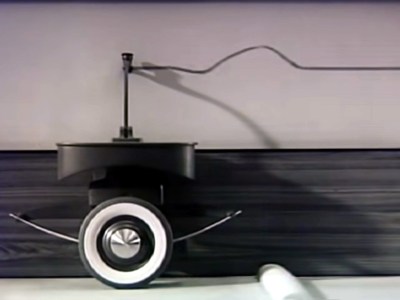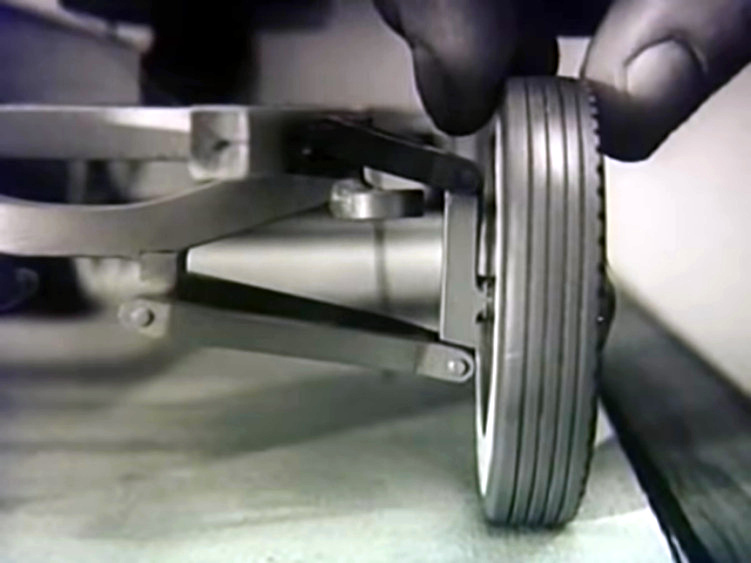In addition to driving home the need for Steadicam or Optical Image Stabilization, this eighty-year-old video illustrates some elegant solutions the automotive industry developed in their suspension systems. Specifically, this Chevrolet video from 1938 is aimed at an audience that values science and therefore the reel boils down the problem at hand using models that will remind you of physics class.

The problem is uneven ground — the “waves in the Earth’s surface” — be it the terrain in an open field, a dirt road, or even a paved parkway. Any vehicle traveling those surfaces will face the challenge of not only cushioning for rough terrain, but accounting for the way a suspension system itself reacts to avoid oscillation and other negative effects. In the video this is boiled down to a 2-dimensional waveform drawn by a model which begins with a single tire and evolves to include a four wheeled vehicle with different suspension systems in the front and the rear.
Perhaps the most illuminating part of the video is the explanation of how the car’s front suspension actually works. The wheels need to be able to steer the vehicle, while the suspension must also allow the tire to remain perpendicular to the roadway. This is shown in the image at the top of this article. Each wheel has a swing arm that allows for steering and for vertical movement of the wheel. A coil spring is used in place of the leaf springs shown in the initial model.
You probably know what’s coming next. The springs are capable of storing and releasing energy, and left to their own devices, they’ll dissipate the energy of a bump by oscillating. This is exactly what we don’t want. The solution is to add shock absorbers which limit how the springs perform. The waveforms drawn by the model encountering bumps are now tightly constrained to the baseline of flat ground.
This is the type of advertising we can wholeheartedly get behind. Product engineers of the world, please try to convince your marketing colleagues to show us the insides, tell us why the choices were made, and share the testing that helps users understand both how the thing works and why it was built that way. The last eighty years have brought myriad layers of complexity to most of the products that surround us, but human nature hasn’t changed; people are still quite curious to see the scientific principles in action all around us.
Make sure you don’t bomb out of the video before the very end. A true bit of showmanship, the desktop model of a car is recreated in a full-sized Chevy, complete with “sky-writing smoke” to draw the line. I don’t think it’s a true analog, but it’s certainly the kind of kitsch I always look for in a great Retrotechtacular subject.















That explained it better than most articles and videos i’ve watched.
Makes you want to go over to archive.org and start watching.
Chevy made a lot of videos in that era, each explaining basic automotive concepts.
I especially like the combination of the one from 1930 or so explaining how their brake system used heavy steel rods to connect the brake pedal to the brakes. Solid steel is much better than using hydraulics. A few years later, another video explained how hydraulic brakes are superior to outdated mechanical brakes….
I think they went on into the 50s too, I feel like I remember similar film saying why their 2 speed partially manual automatic was superior to the new torqueflite and then 1 made a few years later saying why their hydramatic was better than their old 2 speed LOL
Yes. Despite the age of CGI, modelling, and video editing software, the most informative and understandable training materials seem to be WWII-era B&W films produced by industry or the military.
that’s the difference when you turn the knob to 100% education and 0% marketing. Once we heavily applied psychology to marketing and formalized the metrics for measuring the success of marketing campaigns is where we drove our society off the rails.
Of course this film, like all films distributed by manufacturers, during this era where marketing under the guise of being educational. Marketing, is only one factor of many that has been detrimental to society, but marking has to be as old as commerce. This is not the forum for that, so I’ll leave this hanging in the wind.
There is a significant difference between marketing before the mid-20th century and modern marketing. The level of manipulation is quite a bit more formalized and sophisticated now. A lot of this has to do with the application of data, psychology, and the scientific method. Marketing has increased in efficiency without factoring in the damage it does to society.
Apparently Jim Blinn and his works do not exist in your reality.
I remember the one in the related videos. That was the first thing that made a rear differential finally really click when I was just a kid.
https://www.youtube.com/watch?v=yYAw79386WI
Of course this just demos a plain differential. New ones have fancy torque control and stuff so it doesn’t send all the power to a slipping tire if one loses traction completely.
I soppose I’m one of those lucking enough to to visualize what is being by the written word. My grandfather’s early 20th century auto mechanics trade school text book should, the video you referenced I have seen before, and proved my mind’s visualization correct correct. I uded to wotk in the oilfield. When twin screw trucks on a dry high traction location, the popping from the rears axles went to show rderrentials are imperfect under many conditions.
OK. now do a follow-up about the way Citroen solved the suspension problem. My ride: A Citroen BX. speed bumps? what speed bumps?? https://youtu.be/_T_LKsLSyFY
Amen brother! Hydropneumatics or death.
My BX makes little of my MK1 C5 in terms of ride comfort. And both of almost everything else on the road 😋
Paraphrasing Doc Brown ” Roads? We don’t need no paved roads where we’re going” (enters a CX)
Always wanted a turbodiesel BX, seemed like a do-everything-mobile
More on how Citroen engineered Traction Avant model (1934) and how he came to the solutions used in this car:
https://youtu.be/k-rIgMkrU4A?t=301
– independent front suspenssion
– front-wheel drive
Nice video. “Ghost Riders in the Sky” as background music.
Hydro-pneumatic suspension is super cool until you find a puddle of oil under the car and your fancy suspension doesn’t work anymore. My former employer had a DS and a beautiful metallic green CX. I remember some of the struggles to keep them operating, though you run into issues like that with any old car.
That and french electricals ….
Yep. The low pressure return hoses on the bx are a perfect example of design for production in stead of design for sevice. Someone thought it was a good idea to first gather a few return hoses to one central point on top of the subframe ad then let just two or three go to the oil reservoir. Unfortunately that spot turned to be almost unaccessable for a repair. When I gave my engine a overhaul (rubber seals were all stiff and non functinal) I changed that horrible setup with easier to reach junctions and clear flexible hoses on a different spot in the vehicle.
But a big plus of the suspention is the automatic level correction. No matter if the car is empty or has 500Kg on board. It will always stay level to the ground. No need for headlight level controlls
A mech engineer told me that I want to use a spring/suspension system that have a low self-resonant frequency for high frequency vibrations and vise versa. The rest is about damping i.e some kind of lossy element to dissipate the energy. Nothing worse than your suspension system resonating with the vibration.
Been there, done that with an old Chevy that had two dead shocks in the rear. Made going down the road a dangerous but somewhat comical affair. The back of the car bounced up and down constantly, and if I wasn’t careful the oscillations could build up and actually cause the rear tires to hop off the ground!
Needless to say, I replaced those shocks just as soon as I was able to.
Or you work with it and have fun :-) – Used to have a runner car at a place I worked at many years ago where the rear dampers were shot, and pumping the brakes at the resonant freq you could get the back end bouncing in the air.
Am I the only one who caught this ? At 6:59 in the video you can clearly tell the body frame was kept from jolting up and down. It was not free to move like it was in the other previous tests.
+1 – agreed – looks that way to me also.
The first thing I did after watching the video was scan the Youtube comments to see if anyone had mentioned it. Unsurprisingly, no one did.
I noticed this too.
I’m guessing rigid mounting was necessary to present the point because the mass of the chassis is so low, it would bounce everywhere at full demonstration speed. However, their argument is still valid even if their testing is a little rigged and contrived.
Someone does mention your observation in the comments. Another person noticed an additional shadow on the final test versus one of the earlier 4-wheel, full chassis tests.
Regardless, this was a great video. I especially like the way they showed the movements translated to a drawn line. Simple, yet effective.
Love those Jam Handy films. Handy was an olympic swimmer and is often credited as the first person to envision distance learning.
https://en.wikipedia.org/wiki/Jam_Handy
There’s a lovely old British Pelican book on electronic computers and how suspension problems were modelled by analogue mechanical computers before them.
Watched one set in the 50s or thereabouts about lead-acid batteries the other day. Practical science lesson, gotta love these documentaries.
Periscope Films on YT.
Ah, lever arm dampers! My MGB has those.
Has anyone else seen the youtube video with the Bose car suspension? What a hoot!
https://www.youtube.com/watch?v=3KPYIaks1UY